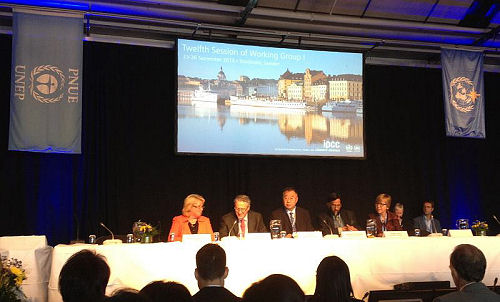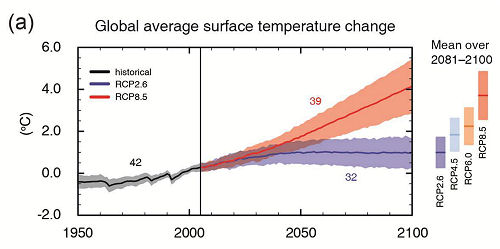Summary for Policymakers of the Fifth Assessment Report - Working Group I of the Intergovernmental Panel on Climate Change released
27 September 2013
The Twelfth Session of Working Group I (WGI) of the United Nations Intergovernmental Panel on Climate Change (IPCC) took place from 23 to 26 September 2013 in Stockholm, Sweden (Figure 1) to approve the Summary for Policymakers (SPM) of the Fifth Assessment Report (Climate Change 2013: The Physical Science Basis), or AR5. Mr. Edwin Lai, Assistant Director of the Hong Kong Observatory, joined the meeting as part of the Chinese delegation (Figure 2).Released on 27 September, the SPM reaffirmed the finding of the Fourth Assessment Report (AR4) on the observed and unequivocal warming of the Earth's climate, highlighting a number of unusual or unprecedented changes on time scales of decades to millennia:
- the last 30 years (1983-2012) was likely the warmest 30-year period of the last 1400 years in the Northern Hemisphere;
- the Arctic summer sea ice retreat in the last three decades was unprecedented in at least the last 1450 years;
- it is virtually certain that the upper ocean (0-700 m below surface) warmed from 1971 to 2010;
- the rate of sea level rise since the mid-19th century has been larger than the mean rate during the previous two millennia.
Human influence has been detected in warming of the atmosphere and the ocean, in changes in the global water cycle, in reductions in snow and ice, in global mean sea level rise, and in changes in some climate extremes. This evidence for human influence has grown since AR4. It is extremely likely that human influence has been the dominant cause of the observed warming since the mid-20th century.
For future climate projections, a new set of four scenarios referred to as the Representative Concentration Pathways (RCP) was designed in AR5 to consider different atmospheric greenhouse gas concentration trajectories in the 21st century. In the high greenhouse gas concentration scenario, global mean surface temperature (Figure 3) and global mean sea level (Figure 4) for 2081-2100 will likely be in the range 2.6 - 4.8 ?C and 0.45 - 0.82 m, respectively, above the 1986-2005 average.
The SPM can be downloaded from http://www.climatechange2013.org .

Figure 1: The Twelfth Session of Working Group I of IPCC was declared open by H.E. Lena Ek, the Minister for the Environment of Sweden; Prof. Thomas Stocker and Dr. Qin Dahe, Co-Chairs of IPCC WGI; Dr Rajendra K. Pachauri, IPCC Chair; and Dr. Renate Christ, Secretary of the IPCC (from left to right).

Figure 2: Mr. Edwin Lai, Assistant Director (first from left), photographed with Dr. Zheng Guoguang, Administrator of the China Meteorological Administration and also head of the Chinese delegation (middle), and Dr. Qin Dahe, Co-Chair of IPCC WGI (first from right).

Figure 3: Multi-model simulated time series of change in global annual mean surface temperature relative to 1986-2005 (uncertainty represented by shading). The mean and uncertainty averaged over 2081-2100 for all RCPs are given as vertical bars on the right hand side. The high greenhouse gas concentration scenario is labelled as RCP8.5. (source: SPM of IPCC WGI AR5)

Figure 4: Projections of global mean sea level rise over the 21st century relative to 1986-2005. The assessed likely range is shown as a shaded band. The high greenhouse gas concentration scenario is labelled as RCP8.5. (source: SPM of IPCC WGI AR5)